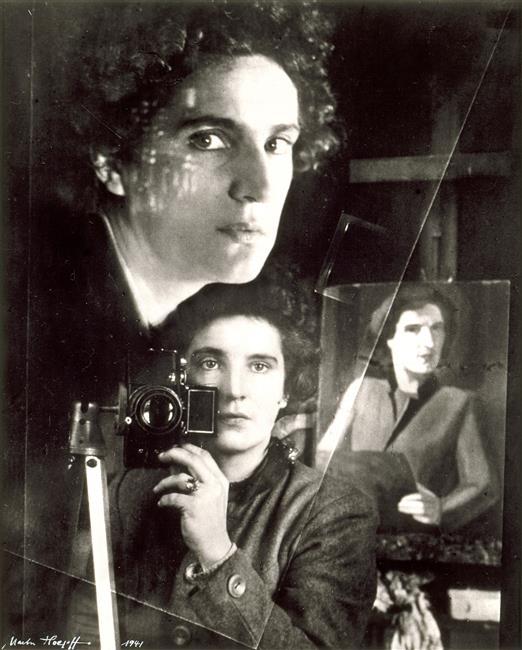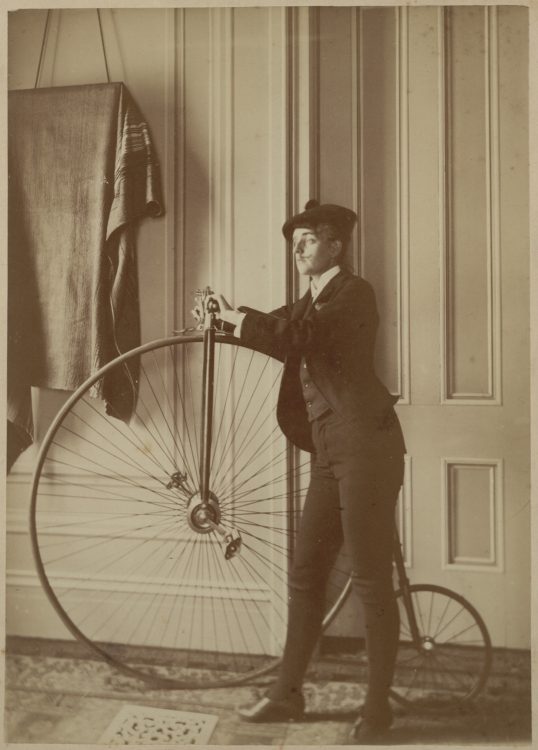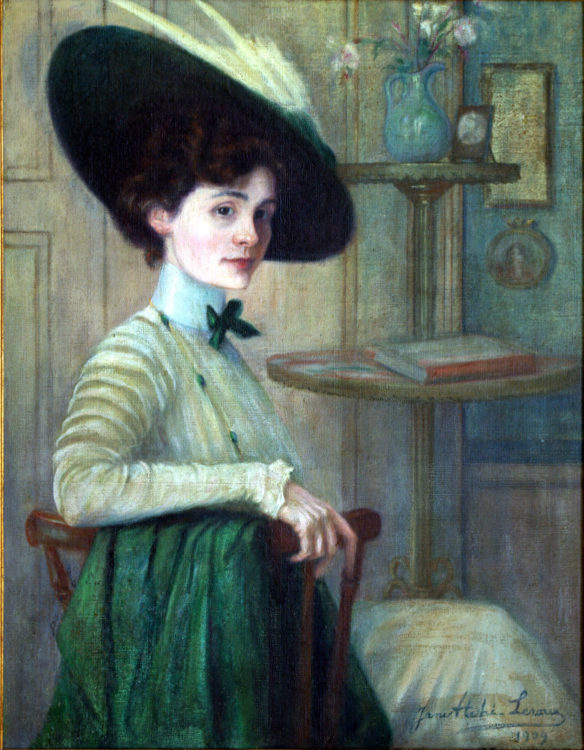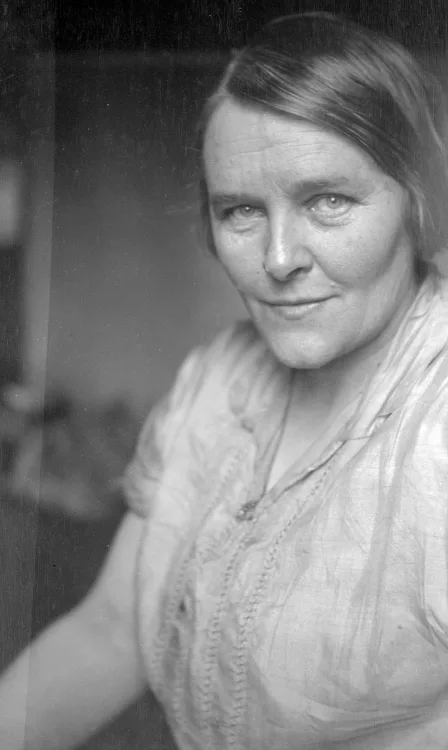Research
Gabrielle Hébert, born d’Uckermann (assigned to), Jeune fille nue allongée dans l’herbe, 1885-1896, 7.7 x 10.6 cm, Musée Ernest-Hébert, en dépôt au Musée d’Orsay, Paris, © RMN-Grand Palais (Musée d’Orsay) © Photo: Sophie Leromain
Gabrielle Hébert (1853-1934), née d’Uckermann, was married to the painter Ernest Hébert (1817-1908). She took up photography in 1888 during her husband’s second term as director of the Villa Médicis, under the tutorship of pensioner Alexis Axilette (1860-1931), a painter and photographer from Angers. The photographs she took there are now part of the collections of the two Hébert de la Tronche Museums in the Isère and in Paris (although the works are currently being kept at the Musée d’Orsay).1
According to her adopted son René Patris d’Uckermann, G. Hébert saw her husband as “a demigod, to the art and life of whom she was entirely devoted”2, an assertion that makes her appear as a submissive wife who seems to have taken up photography as a mere pastime. The extent of the collection, a result of G. Hébert’s prolific production – she made over 3,500 prints in less than a decade – as well as her discreet nature, are what first sparked our interest in the Musée national Ernest-Hébert. After studying the museum’s corpus (photographs and diaries), as described in this dissertation, we felt it would be fitting to examine her practice of photography, which, although it is specifically that of a wealthy 19th-century “user-hobbyist”3, also provides an important insight into her personality.
Indeed, while G. Hébert’s production focused mainly on ordinary subjects, it gives us further evidence of her condition both as a woman and within society. This is not to say that her artistic practice was typically feminine; however, it seems that it enabled her in some respects to assert herself as a creator rather than merely as E. Hébert’s wife within a predominantly male circle of acknowledged artists.
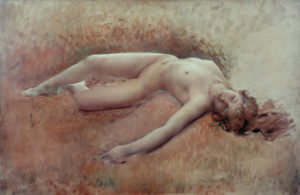
Alexis Axilette, Femme nue couchée, oil on canvas, Musée des Beaux-Arts, Angers, © Musées d’Angers © Photo: P. David
A series of 24 female nude photographs – a rare occurrence at the time and in comparison to the rest of her work – upends the idea of a quiet and reserved Gabrielle. Although these pictures have been studied in-depth, doubt still remains as to the conditions in which they were taken. A painting by A. Axilette kept at the Musée des Beaux-arts in Angers features the same model and composition as one of the photographs at the Ernest-Hébert Museum in Paris. It remains unclear whether G. Hébert or A. Axilette operated the camera, or if the photograph was meant to be used by the painter as inspiration for a study from nature. However, the fact that Gabrielle kept some twenty photographs of nude women is proof of the photographer’s transgressive tendency.

Gabrielle Hébert, née d’Uckermann (assigned to), Ernest Hébert et un chien, 1er août 1905, 1905, 8.7 x 8.6 cm, musée Ernest-Hébert, en dépôt au musée d’Orsay, Paris, © RMN-Grand Palais (musée d’Orsay) © Photo: Stéphane Maréchalle
Lastly, G. Hébert, who did not present herself as an artist per se, clearly developed a keen interest in the photographic technique, making use of several different cameras in order to make the most of each of their specificities. She was at times also known to cut or crop her photographs and make several prints of the same picture by using various toning processes.4 Traces found on the negatives prove that they underwent research of a potentially artistic nature. Furthermore, G. Hébert took great care of her photographs, which she annotated meticulously and sorted into albums, as well as of her glass negatives, which she classified and kept in labelled boxes.
G. Hébert’s extensive photographic production is a testament to her social status and artistic background, as well as to her condition as a “wife of”, a status from which she seems to have wanted to break free. While this study, which echoes the double exhibition Qui a peur des femmes photographes? 1839-1945 at the musée d’Orsay and musée de l’Orangerie5, is not meant to be comprehensive, it does help us reconsider the place of women in the democratisation of the photographic medium at the turn of the 19th century.
First year Master’s degree thesis, directed by Dominique de Font-Réaulx, co-supervised by Marie Robert and Yves Badetz, and defended by Sophie Leromain on 31 May 2017, at École du Louvre (Paris), with the title À l’ombre d’Ernest: Gabrielle Hébert (1853-1934), la production d’une femme photographe, épouse de peintre [In the shadow of Ernest: Gabrielle Hébert (1853-1934), the production of a woman photographer and painter’s wife].
Located at 85 rue du Cherche-Midi (Paris, 6th arrondissement) since its creation in 1977, the musée Hébert was closed in 2004 for an indefinite period following major deteriorations, and its collections became inaccessible to the public. In 2003, when the public institution of the musée d’Orsay and musée de l’Orangerie were created, the musée national Ernest-Hébert and its collections were associated with them. When the museum closed, its collections were transferred to the Musée d’Orsay, where they remain to this day.
2
René Patris d’Uckermann, Ernest Hébert, 1817-1908, Paris, RMN, 1982, p. 216.
3
The expression “user-hobbyist” (“amateur-usager”) was coined by Clément Chéroux (Chéroux Clément, “Le jeu des amateurs. L’expert et l’usager [1880-1910]”, in Gunthert André & Poivert Michel, L’Art de la photographie, des origines à nos jours, Paris, Citadelles et Mazenod, 2007, p. 255-275).
4
Toning is a chemical treatment used during the printing process to give the photograph a specific finish.
5
Qui a peur des femmes photographes? 1839-1945 (Who is afraid of women photographers?). 1839-1919: Musée de l’Orangerie, Paris; 1918-1945: Musée d’Orsay, Paris, 14 October 2015 – 24 January 2016, curated by Ulrich Pohlmann, Thomas Galifot, and Marie Robert.
Sophie Leromain, "Gabrielle Hébert, a woman photographer and painter’s wife." In Archives of Women Artists, Research and Exhibitions magazine, . URL : https://awarewomenartists.com/en/magazine/gabrielle-hebert-femme-photographe-epouse-de-peintre/. Accessed 4 July 2025




